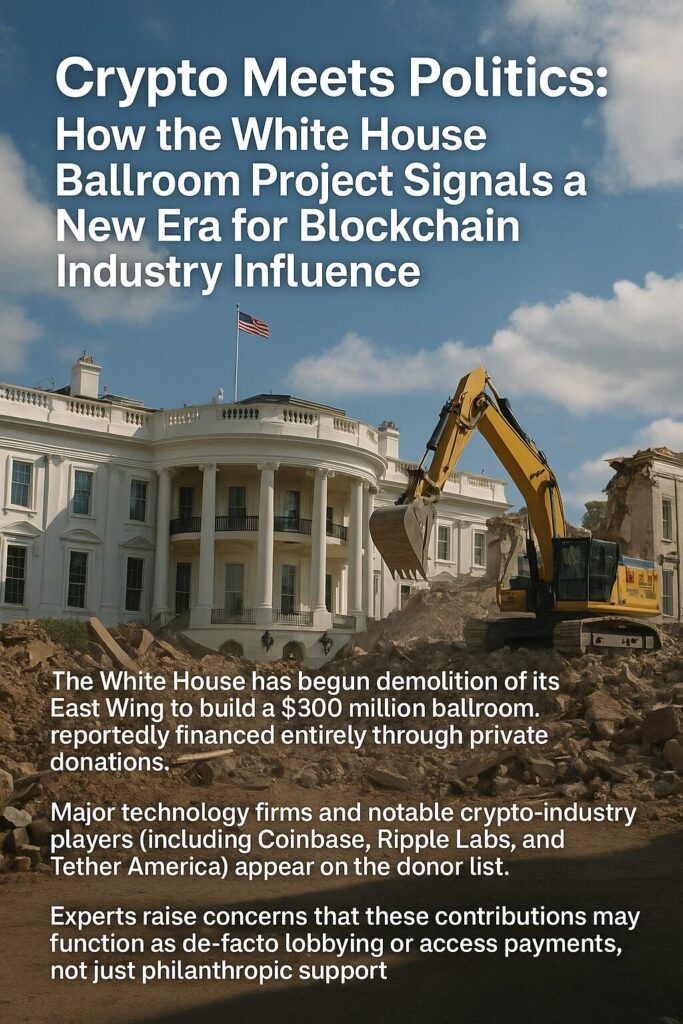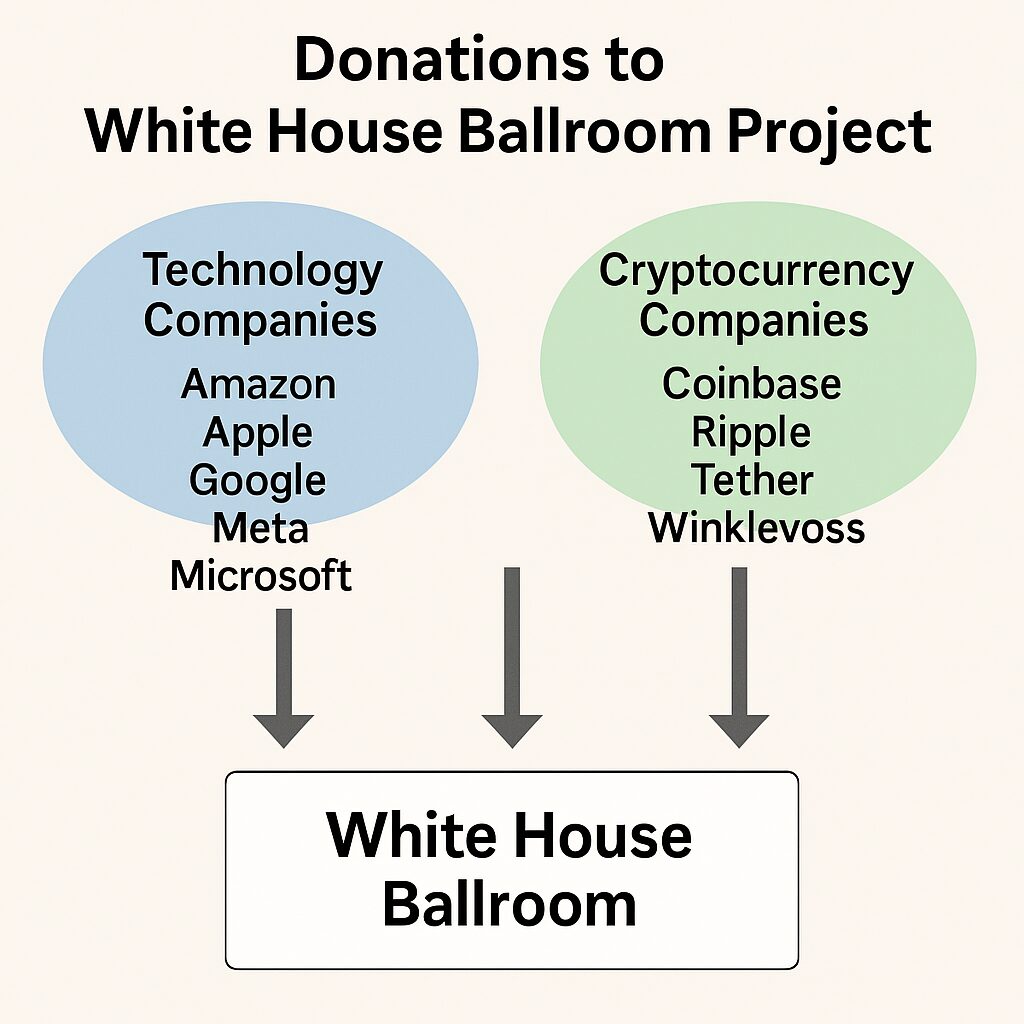
Main Points :
- The White House has begun demolition of its East Wing to build a $300 million ballroom, reportedly financed entirely through private donations.
- Major technology firms and notable crypto-industry players (including Coinbase, Ripple Labs, and Tether America) appear on the donor list.
- Experts raise concerns that these contributions may function as de-facto lobbying or access payments, not just philanthropic support.
- For the blockchain/crypto ecosystem, this signals a deeper integration with political power and regulatory processes—potentially accelerating favourable policy but also raising governance risks.
- For investors and practitioners looking at new assets or applications, the event underscores that regulatory/back-office shifts are as important as technology development itself.
1. Background: The Ballroom Project
In October 2025, the White House publicised that the full demolition of its East Wing had commenced in order to construct a new 90,000-square-foot ballroom, at an estimated cost of $300 million. The project is described as being privately funded, with no taxpayer funds directly used, according to statements from the administration.
The donor list released included 37 companies and individuals, encompassing major tech firms, defence contractors, and importantly for our focus, cryptocurrency-industry players.
From a pure factual standpoint: this is not merely a renovation exercise—it represents one of the largest privately-funded transformations of the White House complex in decades.
For readers in the crypto / blockchain domain: while the physical construction may seem remote from token launches or DeFi apps, what matters is the shifting institutional dynamics: the establishment of direct channels between blockchain firms and political power centres.
2. Who Is Donating—and Why It Matters

The donor list has drawn particular scrutiny. Among tech giants included are Amazon, Apple, Google (via Alphabet), Meta Platforms and Microsoft.
From the crypto side: Coinbase, Ripple, Tether America and the Winklevoss twins (owners of Gemini) appear on the list.
Why does this matter? Because many of these firms operate in sectors heavily regulated (or about to be regulated) by U.S. federal authorities. For instance:
- Coinbase is involved in regulatory disputes with the U.S. Securities and Exchange Commission (SEC).
- Ripple has been deeply involved in the crypto-regulation ecosystem and is positioning the U.S. as a crypto finance hub.
The link between donation and potential regulatory benefit is flagged by experts:
“Donors … eye favourable policy, reduced scrutiny or approval for major deals from the White House.”
Thus, for blockchain practitioners this is a sign that “doing technology” is only part of the story—policy/regulatory alignment is increasingly critical.
3. Implications for the Crypto/Blockchain Industry
3.1 Potential for Accelerated Regulatory Momentum
With major crypto firms on the donor list, the industry may benefit from more direct access to decision-makers. For example, the administration has emphasised making the U.S. a “crypto capital of the world”.
This suggests that crypto firms might see more favourable regulatory frameworks, faster approvals (e.g., for exchanges, token offerings, custody models) and perhaps less adversarial enforcement. For an investor or project-builder this means the regulatory tailwinds might strengthen in coming quarters.
3.2 Elevated Political Risk and Scrutiny
On the flip side, the visible intermingling of donors and policy raises governance and reputational risk. The fact that demolition began before required historic-preservation review (per critics) underscores procedural risk.
For crypto projects and investments: alignment with such developments could be a double-edged sword. If the regulatory or ethical backlash becomes severe, the entire sector could face negative spill-overs.
3.3 Strategic Considerations for New Assets and Infrastructure
From a practical application perspective:
- Projects seeking to launch tokens or infrastructure (e.g., wallets, custody, DeFi) should factor in the evolving game-theory of political/regulatory alignment, not just code.
- Investors evaluating new crypto assets may want to assess the regulatory embeddedness of the token issuer: Do they have meaningful relationships or access? In some cases, such connections could become competitive moats.
- On the build side, alliances with policy-savvy advisors may now matter more. Blockchain firms historically framed themselves as outside the “old guard” — this story suggests they’re entering the “inside game.”
4. Recent Developments & What to Watch
Several adjacent developments reinforce how this event ties into broader crypto trends:
- The administration recently pardoned Changpeng Zhao (CZ), founder of Binance, signalling a friendlier posture towards major crypto actors.
- Congressional scrutiny is mounting: lawmakers have sent letters to donor companies demanding transparency on donation amounts and potential quid-pro-quo arrangements.
- Public polling indicates over 50 % of Americans disapprove of the Ballroom project and its funding model, signalling reputational risk for large-scale donor-political linkages.
For blockchain stakeholders, these mean:
- Keep an eye on regulatory bills or executive orders emerging from the capital: projects backed by donors may see quicker or smoother passage.
- Monitor enforcement trends: if political tailwinds hold, expect more regulatory clarity—but if backlash accelerates, risk of tight scrutiny increases.
- Evaluate token projects for whether they have meaningful structural/regulatory backing versus purely technological ambition.
5. What This Means for Investors and Builders
If you are looking for new crypto assets or building a blockchain application (e.g., wallet, DEX, token offering), the key takeaways are:
- Don’t focus only on protocol features (e.g., speed, consensus) — also assess regulatory/regime alignment, partnerships, and political ecosystem risk.
- Assets tied to firms with established political/regulatory relationships might see first-mover advantage in favourable jurisdictions (e.g., U.S.).
- But those same assets carry reputation and regulatory risk if public sentiment turns or if new scrutiny emerges.
- Infrastructure players (wallets, custody, settlement) may benefit from this evolution: as crypto becomes more “inside” the finance regime, the value of compliant, well-regulated solutions increases.
- Conversely, purely “rogue” or “underground” assets may become less viable in jurisdictions seeking to regulate or curtail unapproved offerings.
6. Conclusion
In summary: The White House’s announced ballroom project and its donor list mark a symbolic and substantive moment for the crypto/blockchain industry. The inclusion of firms like Coinbase, Ripple and Tether within a major political-funding effort signals that blockchain is no longer merely disruptive technology—it is formally stepping into the corridors of power. For participants in the crypto ecosystem — whether investors, builders or strategists — this underscores a shifting game-board: regulatory access, political alignment and governance posture matter just as much as technical innovation.
At the same time, this deeper integration comes with increased visibility, heightened scrutiny and new forms of risk. Projects and assets navigating this space should consciously integrate regulatory strategy, stakeholder governance and reputational discipline from the outset. For those who do so, the opportunity may be significant: in the emerging “asset-backed representation” side of blockchain finance, aligning with institutional power could translate into meaningful advantage. But it is not without its caveats—and prudent practitioners will map both upside and risk.

